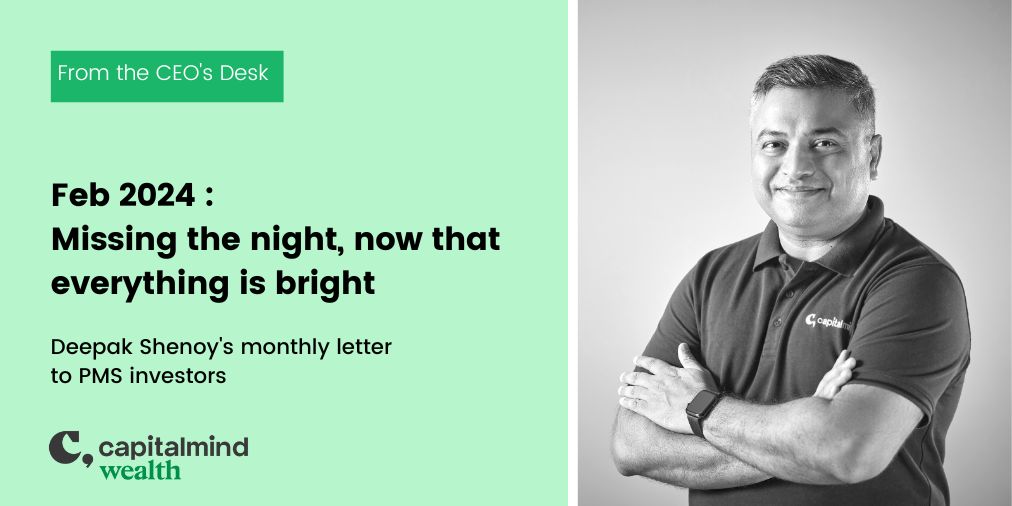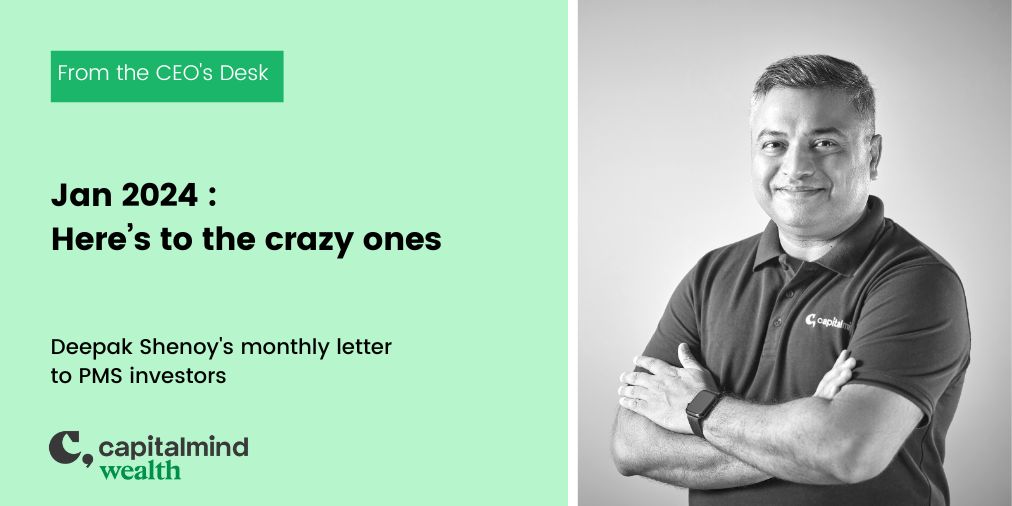[This is an excerpt from the July 2021 letter to Capitalmind PMS Clients]
India has a strange set of rules for movies. When someone is smoking on the screen, the movie must show a line that says smoking is injurious to health. This is resented by the moviemakers, who understand that smoking is bad, but they want to have the viewer’s full focus, and not distract them regularly. Tobacco companies obviously don’t like the legislation, and viewers don’t necessarily care, though there is a slow subliminal message being created of cigarettes being bad things.
In order to “approve” a movie, all moviemakers must include the “injurious” line when someone is smoking. The concept of “approval” is what is allowed to be shown to Indian audiences, in a movie theater or on television. But the internet changed everything.
A movie is no longer something that fits the traditional concept anymore. People can use smartphones and put their videos on sites like youtube. That qualifies as entertainment now, and youtubers have audiences that many movie makers would long for. Yet, the rules do not, and perhaps cannot be applied to online movies. If you ban the online sites, you risk losing out on an entirely new generation of innovation – and it is this innovation that has created hundreds and thousands of moviemakers, not just from those few families that created blockbuster movies in the past so their kids get to run the largest production houses. The scale of this innovation is immense, and while it happens, it breaks all the rules that bound the traditional lot.
A similar story plays out in taxicabs. You had to have a license, in Mumbai, to run a taxi. The authorities needed to cut the number of taxis because there were too many of them, and no one was making money; they restricted the total number of licenses and didn’t issue new ones for 20 years. A license was considered prestigious. But people weren’t able to get enough taxis, and there was an “all India permit” that allowed taxis to be registered to operate anywhere. Only rule: you had to “book” them, they couldn’t be hailed on the street.
Technology came in and rapidly changed this. Book on an app, and get a taxi. The earlier forms of this were taxi fleet operators who would own the taxis and hire drivers. Now, the Ubers and Olas of the world tell the drivers they have to buy their own cars, and use them with the appropriate permits. Suddenly there’s taxis everywhere, and the rules of “permits” no longer exist. The very thought process that kept the number of taxis low was bashed up by newer, more capable tech. Before Corona, every second or third car in Bangalore on the road was an Uber/Ola taxi, and the drivers complained of a problem: too many taxis on the road, so no one was making enough.
Take telecom. To call someone abroad, in the 1990s, you would have to make an “ISD” call, which was expensive (many rupees per second!). In fact, to call someone within the same state (a different city) you would use “STD” – and the prices would be the highest during the day, then reduce to half after 7 pm and to one-fourth after 11 pm. Enter the mobile telecom providers, who initially made intra-state calling much cheaper (same fares if you were in the same state) and removed the time-based silliness. International calling was still quite expensive and remained so until perhaps 2012 or so. All international calls required a fairly hefty payment to the telecom providers, and everyone in the ecosystem would take their cut.
Technology came in strong. You can now make voice calls on pretty much any technology that’s out there – from Whatsapp, to Skype to what not. You can even make video calls, with bandwidth being immense. Suddenly the concept of ISD or STD etc. is just gone. In fact, so is per-minute billing in most telcos. You buy a plan and you can call for as long as you want, and even on a data plan the amount of bandwidth used is so less that you could keep a line running all day without running huge bills. The whole business model changed – and now there are no Public Call Offices or STD booths.
Journalism too has been disrupted. Earlier, political and economic leaders would speak their views to journalists. Who would then publish their thoughts, appropriately chopped up for reader consumption. In the “chopping up” process, the journalists could edit what they liked, and often, would remove what didn’t fit in with their story. They could also dictate when these views would be published, or whether they would be published at all.
The internet has changed that too. With a platform like Twitter or Facebook, any political or economic leader can speak directly to the public. And they do. From industry stalwarts to even Presidents and Prime Ministers, they all air their minds, unhindered by the gates of traditional journalists. In fact, a good portion of articles nowadays are: A tweeted this, and B tweeted this in response.
All of this is disruptive. To the present regimes. If you start using more solar energy and batteries, what happens to the coal plants? If you use electric vehicles what happens to over Rs. 20,000 cr. collected by the government each month on petrol/diesel taxes? If you speak directly to the public, what happens to journalism? If you buy directly from the farmer, what happens to all the middlemen?
In the movie, Jurassic Park, when the scientists said that the dinosaurs they were breeding were all female so they couldn’t breed (and thus could be controlled), Dr. Ian Malcolm said this: “Life finds a way”. Everyone will eventually survive. (And of course, everyone will eventually die, and the opposite of a great quote is also often a great quote, paraphrasing Niels Bohr)
Technology displaces a lot of things, sometimes for the better, but there are strange consequences. We’re now seeing this in bitcoin and the crypto world. It’s a world without rules and regulations, they say because everything must be free. Well, they get to see all the scams and scoundrels all over again, just that they’re now enshrined in code. Scamsters set up exchanges to eat up your money. Overnight “stable coins” shut down because too many people sold. “Lending” against collateral that is as volatile as bitcoin – so when the coin value falls, the collateral is automatically sold, causing the value to fall more, so more sales happen, and so on. The biggest issue now seems to be “Tether” – a coin that’s supposed to have $1 for every Tether coin issued, but apparently doesn’t.
At some point, the bitcoin revolution will count for something; innovating around trustless blockchain ledgers is a useful concept for etching transactions into eternity. And you need that in many places – like real estate transactions, exam results, or motor vehicle ownership records. But before we reap those benefits, we’ll have to wait as they discover the need for regulation, and possibly the wrath of governments.
What’s the point, Deepak? I hear you say this and I promise to get to it. It’s simply this: what you know and takes for granted today will probably take a different form tomorrow, through technology. While the problems you have today will go away, there will be more eerie problems created by the changes.
In the financial world, our job is to react to change. Not to predict it, because predictions are folly. You can predict a hundred things, and one of them is bound to happen, so you can say you were right. No one sees the ashes of the ones that went wrong.
Reacting is easier. You wait till something becomes a trend, enough for it to sustain. And then you get in. You’ll never get in so early you can be called a soothsayer. You’ll get in after enough people have done so, at a higher price. And in the same way, you’ll be able to get out much after the top, but before the really bad damage hits. In the markets, we say – you might give up the first 10% or the last 10%, but at least you can get 80% of the trend.
In so many ways, that is what momentum is. The trend is established and accelerating. A stock makes a new all time high. And if you just systematically buy those stocks, you’ll win on a few of them that go on to make the 2x, 3x, or indeed, 4x returns that some stocks have seen. And when you lose, you lose 10% or so, and one big winner makes up for enough losers.
Our own momentum portfolio at Capitalmind Wealth has had a stellar run with around 21% return in the last three months against the Nifty’s 8%, and the main thing about that wasn’t the stocks we picked. It wasn’t the stocks we sold. It was just the discipline of sticking with the trend consistently. Even if it were stocks we loved otherwise – we bid our goodbyes professionally.
Think of the people who loved a good story. Would they have stuck with the Nokia feature phones when the world moved to a smartphone? Would they continue to call using STD because that’s what they loved? The idea of moving with the world isn’t new, just that some join it grudgingly and others embrace it early. We like to be somewhere in between; we actually want enough people to win before us so that we know there’s something to win.
As we write this, the thing that old-timers are telling us is: these times don’t last, the speculation is just too much and everything’s going to crash anyway. The even older timers are telling us: No one knows anything about WHEN it will crash, so focus on your discipline. The young will eventually change the world; just that you don’t know which of the young will.
We’re going to have a town hall soon. We’ll try to answer as many questions as we can. In that context, we do have something to say about debt portfolios and our absolutely pathetic return on the debt funds we own.
We sacrificed a better return than we could have gotten by taking the risk of using funds that had “shady” debt in the last six months. We avoided anything with banking AT1 bonds, with paper lent to companies that have been on shaky ground, to NBFCs that have high NPAs. Because we believed, and still do, that the crisis in the economy is far from over and that defaults are ahead of us. It’s not just us, even the RBI thinks so, and even SBI, India’s largest bank, thinks so. But until the D-Day happens, the turkey is fattened; so our debt funds which were invested in government debt, have not returned much. We think this strategy will still redeem itself after September when a lot of defaults will come calling. If they do not, we will change our stance.
Meanwhile, equity investments continue to do reasonably well – with market-beating returns from the Momentum, Multicap, and even the Passive market portfolios. Equities have done well, and is it time to add more to markets? Perhaps a steady investing approach will make sense anyhow. The one thing we must acknowledge is that at Capitalmind Wealth, we will take cash calls – as in, we don’t have to remain 100% or even 50% invested in equity at all times – we will change with the tide, so you should expect some high cash positions if markets start to fall heavily.
But we assure you this – every rupee will eventually get invested back, sometimes into the same stocks, sometimes at even higher prices. We love those who live to tell the tale because that means there’s a tale worth telling.
Capitalmind Wealth is probably India’s lowest-cost PMS for handling investment corpuses of INR 50 Lakhs and more. You can see more about our strategies and their performance here. Connect with us on @capitalmind_in or schedule a call with us by filling out this form




